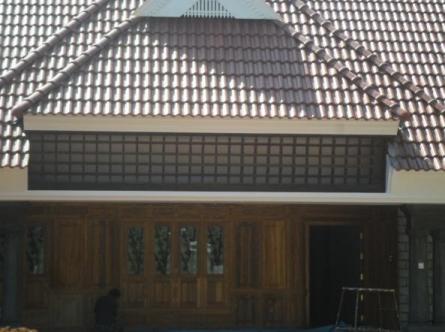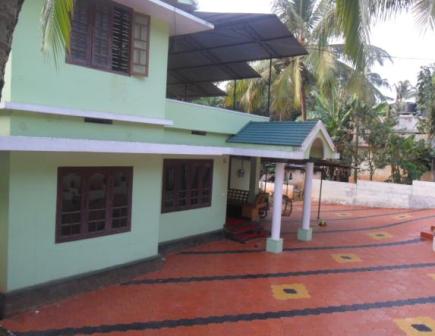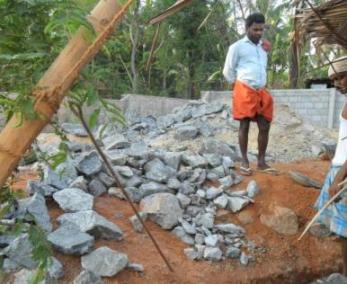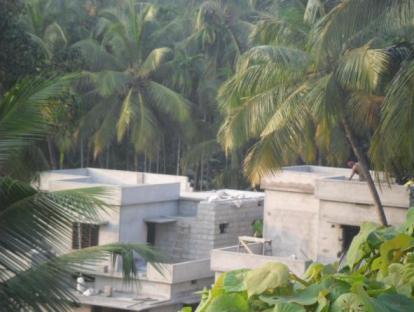Have you decided to construct your home this year? 50+ suggestions for you
When we see some homes, we do feel intense desire to build a home like this or rob it at night. It’s true we spend each and every penny we have earned to complete a home. To buy a property, labour charge and material costs are enough to kill a person. Very often, building a house gives us a lot of burdens. Yet we often fail to compromise our desires with money left in our hand. So, let me give you a few suggestions to start at the planning stage itself. These tips will surely help you a lot to make your cost effective as well as completing it, considering even minute problems.

Before buying the land
- It’s best to choose low elevated plots during rainy season and high elevated plots during summer. You can avoid low elevated plot if water is not drained properly. You can avoid high elevated plot too, if it faces non-availability of water.
- Broker may give you a lot of honey talks as soon as you see a plot. But never fall in his words and give advance suddenly. You should visit the plot at least 5 or 6 times before you take the decision to buy it. If you have doubts, you can seek advice of experts.
- In some places natural bricks are available. If so, house owner may sell the bricks before he sell the land. It may add extra cost to the person who purchases it. The land elevation will deviate and piling may be needed for basement, adding extra cost to your construction. It’s always better to avoid such plots that have undergone such alterations.
- When you buy a land with road on either sides, kindly note this point. If it’s panchayat road, construct your home leaving three meters. In the case of corporations, you need to leave more space. You need to measure the remaining land to know if it’s sufficient to construct your home.
- Your plot should be free of all debts to avoid problems later. You can collect details from town planning department or panchayat. It should have a clear boundary as well. As a part of town planning department, if it forms a part of a commercial project it may be acquired later. If you don’t have enough papers before 13 years, it is very difficult to get loans too, almost impossible.
- Now prices of lands are going up like rockets. If you have a group of good friends or colleagues who plan to build homes in a residential town or city, you can purchase a 10 cent land and build homes as storeys. It is only possible if relationships are good, but it’s cost effective too. This technique is known as ‘pooling of land’.
- Now every home has a car and a two-wheeler and most of us prefer to be away from polluted towns. Places near highways can be bought at low rate. It’s always better to invest money in a properly that can give you high return later. So, less developed places, a little distant away from main towns and cities can be chosen. They can be bought at low rate, but in future prices of such places will surely go up.
- Buy a plot with a clear road for transport. It should be enough to carry at least a mini-lorry. It saves a lot of money for labour for bringing things. Also prices of such plots will increase fast comparing those, with no roads or wide paths.
Plan earlier – A good beginning
- You should decide earlier itself, the total surface area of your construction. If it’s a family of parents and two kids, 1300-2000 square feet house is sufficient. Big house needs a lot of time for cleaning too. It increases your maintenance cost as well as cost for hiring a servant.
- 70% homes are designed by architects. But it doesn’t mean that you should seek help of an architect. Avoid the architects who give you numerous plans and ask you to choose one. Your architect should visit your plot and design a home, best suiting the structure of that plot. Keep in mind, design should fully utilize sunlight and free air available.
- Before choosing architect and contractor you should visit at least a few works of them. If architect says, “Sir, visit this home. It’s a newly constructed one; done only a few months back”, avoid those homes. It’s better to visit his old projects than newer ones before taking a decision. Choose homes that were done at least 2-3 years back. You should clearly examine if those constructions have leaks or damages. Also check if he has done water proofs for joints of concrete roof. If that home was completed with finish, appoint him as your contractor.
- If some contractor approaches you saying, he will do it cheap, think twice before appointing him. Now, it’s not possible to construct a home below 1000 rupees per square feet.
- According to the climate of south India, it’s better to start work during September (Chingam). In the rain of Malayalam month Thulam, 2 months later, basement and floor will be strong enough to build the house. During next June rainy season you can do interior work. House warming ceremony can be conducted next Chingam (August-September).
- A few contractors use beam and columns to avoid walls. They may be used to add more designs too. It gives you double expenditure comparing normal walls. Choose such beams and columns only if you can afford its expenditure.
- Once you have purchased the plot, do some self-research before approaching an architect. You should prepare a project to note where you should place your bedrooms, kitchen, veranda, shelves etc. You can include your tastes as well. It’s a nice idea to collect a few designs of living room, kitchen, bedroom, storage spaces etc before you see an architect. You should choose only a few designs through your research work. Otherwise it gives extra work load and confusion to architect to afford them all.
- Before the design is completed try to include all your necessities. Anything included later will only add up your expenditure. It can destroy the whole plan of your house too.
- Not only elevation and plan, but 3D pictures of interior and exterior can be done with the help of computer graphics. Such plans can give you more clear ideas of your construction.
- You should keep safe the bills, documents, model types and series of materials and contact numbers. You may need them later. Never throw away guarantee cards too.
While preparing designs
- If you have guests at least 4 or 5 days a week, then only you need to spare a separate room for them. If you are trying to reduce the expenditure, you can note this point. It’s better to use a particular area to do a lot of daily activities than completely reserving the space for a guest, whom you can’t expect frequently. For example, if you remove the divider in between living space and dining hall it can be used as party space.
- If you provide double height to common space – living and dining, it may increase total expenses up to 20%. But it reduces the heat inside your rooms considerably, brings enough sunlight too. It let go the feel of suffocation inside the closed rooms too.
- You should design your garden also, along with your house plan.
- Constructing a room for staircase is old fashion. Now it’s the time for open staircases. Now you can bring a little creativity to your wash basin too, to make it an artistic piece.
- TV, fridge, computer, washing machine, music system – reserve their spaces at designing stage itself. Also never forget that technology changes fast. If you want to buy a plasma TV or laptop in future, no need to waste space for computer now. Always keep in mind your future updates too.
- Now everyone uses mobiles and ipods. So, give enough charging spaces and plug points in your rooms.
- If the woman of the house is a working lady, you can choose an open kitchen so that she can teach her kids while busy in kitchen work. She can watch TV placed in living room too.
- If you can’t digest or accept any part of the design, never compromise with architect or contractor.
- Latest trend is smart storage or maximum storage. It’s a better choice to convert one full wall to a wardrobe.
- Now we can’t say anything about power tomorrow. Electric bills are increasing day by day. So, future homes should never need to put on electric lights before 6pm. Light wells from roofs, big windows that open in the direction of sunlight, courtyard inside the home, windows built in the form of arches etc can bring a lot of sunlight inside your rooms.
- Corridors and foyers always stay in dark. Try to avoid such designs from your plan.
- Build big windows in the direction of wind to give good air circulation to your home. If nearby homes block free passage of air, provide big windows in remaining open spaces.
- According to Vasthu, south and west directions are best for bedrooms. These places get direct attack of heat too. So, build wardrobes or bathrooms in these corners as solution.
- Give light shades to walls over-exposed to sunlight to reduce heat inside your home.
- Major daytime is spent in living room and dining areas. If both these rooms provided in west, heat will be comparatively low.
- Latest trends are open living and open dining. If such rooms open towards a garden it’s a pleasant idea.
- Now powder-coated aluminum frames for windows is the latest trend. Though it’s a bit expensive in the beginning, it’s easy to clean and to do maintenance work.
- If you are using concrete parts for fixing doors, assure their quality before purchasing.
- If you use rat trap model presented by Larry Baker while building walls with bricks, you can save up to 20%.
- Concrete hollow bricks, normal bricks, natural stones and exposed laterate blocks – you can choose these bricks also. Concrete hollow bricks are cheap, but increases heat inside homes. Natural stones are easy to build, but needs extra finishing work. Clay is good, strong and gives cool effect too. But it’s bit expensive. If you use interlock bricks, you can save money of polishing and finishing. It’s better to choose materials available most near, to reduce transportation charges also.
- Flooring materials are available in different patterns and ranges. Red oxide is cheap. Granite flooring may cost around 500 rupees per square feet. If you have already decided that you will spend exactly one lakh rupees for flooring, then try to choose materials that can come under that price.
- Now stainless steel is used as hand rails for staircases. Glass is also not as expensive as wood.
- Never think that you will complete the home taking three or four years. Both labour cost and material cost increase daily. Also, extending the project adds additional cost of purchases and labour only.
While choosing building materials
- Give importance to durability than beauty while purchasing materials for your home construction. If you want to avoid leakage of buildings do waterproof treatment before plastering. Now it’s possible to do it in cheap rate – below 1 rupee per square feet.
- Roof with slope concretes are best for our climate. Using less water while concreting and fixing the concrete well can reduce damages and fissures of roofs a lot.
- Never compromise with pipes used for plumbing. Use ISI marked materials only. The joints inside should be made of brass. Then only it can resist leakage and bad smell. But you can substitute high quality taps, closet, wash basins, door handles etc with less expensive money. You can change them later if needed so.
- Use solar water heater instead of electric. It can reduce your electric bill considerably. Though it’s a bit expensive in the beginning you can save a lot of electric bills later.
- It’s better to design plumbing lines of two consecutive bedrooms together. The idea is to design those two bathrooms near.
- Ferro cement slabs are economic than wooden shelves and wardrobes. To make shutters, hundred varieties of plywood are readily available in market. Plywood is cheaper than wood.
- It’s better to purchase building materials first, whose price may increase very soon. You should visit more than 2 or 3 shops before making the final purchase.
- You can provide exhaust fans for your bedrooms, if they are closed full day time. It can take away the excess heat from your room.
- While fixing lamps inside bedroom, keep note that they should never fall directly into your eyes. You can choose concealed lighting or indirect lighting methods.
- No need to construct cornice to place decorative items on walls or pillars. Such items are readily available in market in cheap prices, in cheap wood and other materials. Buy a few pieces as you require and fix them. If not needed you can throw them away easily, but it’s not at all easy to remove a designed shelf or object from your interior.
- Giving yellow or orange shades in your office/working room of your home gives you positive energy.
- You should paint only above the primer, not on the top of putty. Putty is given to cover damages, scratches and fissures of walls.
- Roof tiles chosen should be of good quality. Never choose low quality ones that fade with a rainy season. Paint a coat of anti-fungal paint on its top for durability and resistance against fungal attack.
Six things that can be postponed
- If you don’t have enough money in hand, give CFL lamps to power points. When you get enough money you can buy expensive lamp shades.
- Everyone loves to live in a home full of colours. But if your money stock is empty what to do? Now apply a white coat, it looks simple too. After two or three years you can make it colourful according to the latest trend.
- You can use old furniture now. Even the cheap furniture, if placed in your interior gives a new look to your home. You can postpone that task as your next target.
- Italian curtains and Victoria curtains give royal touch to your interior. If you can’t afford it now, fill your interior with readymade curtains. You can change them later.
- You can give points to hobs and chimneys and fill them later when you get money.
- It’s better to design garden later than doing it now at low cost.
Like it on Facebook, Tweet it or share this article on other bookmarking websites.




